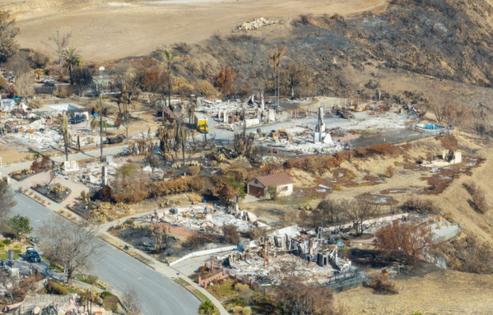Fire that burned almost 250 homes in Ventura County fire was restart of earlier blaze, officials say
Published in News & Features
LOS ANGELES — A fire that burned nearly 250 homes in Ventura County was a rekindling of an earlier fire that officials failed to fully extinguish, according to an investigation by Ventura County fire officials and prosecutors released Friday.
The findings put more focus on the tactics firefighters use in declaring blazes out, especially after authorities concluded that the destructive Palisades fire was a restart of a Jan. 1 fire that the Los Angeles Fire Department wrongly declared fully out. In the case of the Ventura County fire, officials said they knew there were hot spots remaining, but did not think they’d cause any problems.
The failure to put out the Jan. 1 fire has sparked outrage and a federal investigation.
The Mountain fire that started in Ventura County on Nov. 6, 2024, burned across 31 square miles, leaving some streets little more than ash and chimney stacks.
At a press conference Friday, authorities said the fire came back to life thanks to a blown tractor tire.
About a week earlier on Oct. 30, a tractor caught fire in Somis while clearing brush, officials said. Firefighters responded, along with a C-130 air tanker and together they held the fire to 1.8 acres. The next day, officials said, crews flew a drone that can see hot spots over the area and detected heat near the fire’s edge and the tractor wheel.
Though the temperature around the wheels was registering at 300 degrees, Ventura County Fire Chief Dustin Gardner said that’s not unusual for equipment caught in a fire.
“As an example, if you look at a tailpipe right now going in the parking lot, it would be more than 500 degrees. So it was a carcass of steel that had been burned up within the middle of the fire with more than 200 feet away from the green,” he said, referring to green vegetation that’s fuel for a fire. “After an assessment the conditions and the containment measures in place the decision was made to close the incident and return control to the property owner.”
But a week later, powerful Santa Ana winds arrived and coupled with single-digit humidity, turned the landscape into bone-dry tinder ready to burn.
On Nov. 6, the fire came back to life amid a Santa Ana wind event that was generating 70- to 80-mph wind gusts, which kept firefighting aircraft out of the fight
“Our arson investigators have determined the most likely cause of the Mountain fire was extreme winds dislodging a pocket of covered hot tire debris from an earlier fire,” Gardner said.
Winds launched burning firebrands into the hillside neighborhoods, where it destroyed scores of homes. In Camarillo Hills, the epicenter of the wave of destruction, 182 homes were destroyed.
Ventura County District Attorney Erik Nasarenko said that a criminal investigation into the Mountain Fire revealed no evidence of criminal liability and therefore will not be filing charges, including against the tractor owner. The tractor operator had more than two decades of experience and was operating a 2023 tractor in an appropriate manner when it caught fire, Nasarenko said. Regardless, the county fire department said it would tap a third party to an independent investigation.
Most of the area burned by the Mountain fire was in a sparsely populated area in the Santa Susana Mountains north of Highway 118. But the fire’s progression on Nov. 6 saw the blaze jump the highway and engulf a suburban neighborhood in the Camarillo Hills. Residents fled for their lives and none were lost. But for the next two days, firefighters were on the defensive before eventually containing the fire.
The devastation was concentrated on a handful of streets, which were surveyed by state and county officials. On Santa Cruz Way, 89% of homes were destroyed or sustained at least minor damage. West Highland Drive saw the highest number of homes severely impacted, with 33 out of 50.
The area within the Mountain fire perimeter has seen eight significant wildfires in the last four decades. Most began in the fall, when Santa Ana winds can become particularly dangerous.
While the area’s chaparral ecosystem evolved to withstand some wildfire, repeat burns every 10 or so years can create a feedback loop that erases the larger, more resilient shrubs and allows for flammable invasive grasses to take over. That phenomenon was particularly relevant last fall, which followed a hot late summer after two wet years and experienced extreme growth. About 30% of the area burned by the Mountain fire was grassland, according to a Los Angeles Times analysis of land cover data.
Ventura County was also the epicenter of two other devastating recent fires, both of which were sparked by power lines.
The 2017 Thomas fire destroyed over a thousand buildings as it tore through 281,000 acres of Ventura and Santa Barbara counties, becoming the largest wildfire in state history at the time. Two people were killed.
A year later, the Woolsey fire ignited under similarly heavy winds in Simi Valley. The blaze ultimately destroyed 1,600 structures — mostly in Los Angeles County — and killed two people.
Many of the streets in this area are lined by ravines, which can prove particularly dangerous during wind-driven ember fires. Should an ember land at the bottom, fire can can climb uphill on both sides.
©2025 Los Angeles Times. Visit at latimes.com. Distributed by Tribune Content Agency, LLC.







Comments